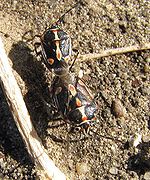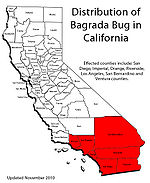Bagrada bug
| Bagrada bug |
|---|

|
| Scientific Classification |
|
| Binomial Name |
|
Bagrada hilaris |
The Bagrada bug is a species of stink bugs known by the scientific name Bagrada hilaris. It is also known as the painted bug or harlequin bug.[2] It is perhaps best known as an invasive species responsible for the destruction of crops. It has mainly invades the western coast of the US, but it can be found in the eastern areas as well. It likes warmer temperatures, which is why it is commonly found in California. It is a dark brown or black color. It has spots on its wing pads that are a mix of orange, white, and yellow, which is how it also got the nickname "harliquin bug". It has a mouth made for piercing plants to suck out the sap. It is classified as an insect because it has 6 legs. It has 5 nymph stages before it matures into an adult. It grows wings and slightly changes color from bright red to its adult colors as it matures. When they reproduce, a male and female stick their ends together, and can commonly be found walking around like this. Once the Bagrada bugs have mated, the female lays the eggs in the soil around the base of plants. They feed on the sap from plants. They mainly feed on crucifers, but they will eat other kinds of plants as well.
Body Design
The bagrada bug has 5 stages of development and they all look different. The eggs of the bagrada bug are just very small tan/white balls. The first instar(the stage of an insect or other arthropod between molts)of the bagrada bug looks like a small lady bug that is completely red, it is red from top to bottom. The third instar looks like a lady bug with wide back stripes diagonally across it. The late instar of the bagrada bug is completely black base and some white and orange stripes. The adult bagrada bug is 5-7mm and 3-4mm wide at its broadest point. Its upper surface has a mixture of black, white and orange markings. that is how it got the names harlequin bug or painted bug. [3]
The Bagrada bug has a special mouth type for how it eats. it has a mouth piece that is made for piercing leaves of plants and suck out the sap. it eats mostly major crops like arugula, broccoli, cabbage, cauliflower, Chinese greens, kale, kohlrabi, mustard, radish, rutabaga, and turnip.[4] It has only 6 legs classifying it as a insect and not spider. Some think it is a beetle but it is not.
Life Cycle
The Bagrada bug (Bagrada hilaris) hatches from tiny white eggs that are laid by the adult on leaves or on the soil under a host plant. Once hatched, it goes through an incomplete metamorphosis of five nymph stages (young stages that resemble the adult) before become a fully grown adult. During the nymph stages, the wings slowly develop and the colors of the body change.[3] In the first nymph stage, the Bagrada bug has a reddish-brown colored head, and a light red body. As the bug passes through the various other stages, it slowly becomes darker, until it is completely black with orange spots. In all of the nymph stages it is able to feed on plants, but the adults cause the most damage. The entire life cycle of the bug takes about three to four weeks.[2]
When the Bagrada bugs are at the adult stage they can reproduce. They do this by attaching their ends together, and are often seen walking around in pairs end-to-end. The female adults are larger than the males and can lay around 100 eggs in two to three weeks. The eggs are often found in small clusters and take about a week to hatch. The eggs gradually turn from white to orange and are oval shaped.[5]
Ecology
The Bagrada bug originated from the Eastern and Southern areas of Africa and also Egypt, Zaire and Senegal. [3] The bagrada bug lives more in the desert biome.[6] A biome is an area that shares a similar climate with another area The Bagrada bug live and hide in soil that is high in clay that is more dry. They thrive better hot growing climates and are more active in the heat of the day. This is most likely why the painted bug likes to be in southwest America. When it gets warmer than normal the population grows much larger.[7] The Bagrada bug eats mostly plants from the Brassicaceae (Cruciferae) family. Examples are broccoli, cauliflower, and cabbage.[4] The painted bug feeds more off of plants that do not use a lot of pesticides like organic gardens and community gardens for example.[2] The Bagrada bugs a have native predator. It is a tiny wasp called the Scellionidae Wasps that are parasitic on its eggs.The Hover fly is a predator to the adult Bagrada bug and stink bugs in general.[8]
Agricultural Impact.
The Bagrada bug, also known as Bagrada Hilaris, is native in Africa and infests parts of Asia and Europe. It also damages crops in the US with equivalent destructive force as was found in the eastern hemisphere.[9]. It was first found in the US in Los Angeles, CA in 2008. It caused damage to several crops including broccoli, cauliflower, radishes, and many others by the next year.[9] By 2011 there had been fewer bagrada bugs and thus less destroyed crops. [10]
They feed mainly on crucifers, but they can infest other crops like solanaceous plants like potatoes, malvaceous plants like cotton, leguminoseous plants like legumes, cucurbits like watermelon, and graminaceous plants like grain.[9]. Bagrada bugs have mouthparts that let them suck on the juices from plants. Damage can vary depending on what kind of plant they infest, and what parts of the plant they infest. Damage caused include stippling with necrotic spots, stunted growth, loss of apical dominance, and formation of multiple heads to death.[9]
If the plants are healthy there is better chance of defeating the bagrada bugs. If the plants are already infested they should be sprayed with a 1 or 2 % insecticidal soap. If they are about to plant the plants turn the soil over repeatedly to crush the bugs.[11]
Impact of Bagrada bug on desert cole crops based on chemical control.
| Direct seeded | Transplanted | |||||||
|---|---|---|---|---|---|---|---|---|
| row 1, cell 1 | row 1, cell 2 | row 1, cell 3 | row 1, cell 4 | row 1, cell 6 | row 1, cell 7 | row 1, cell 8 | ||
| row 2, cell 1 | row 2, cell 2 | row 2, cell 3 | row 2, cell 4 | row 2, cell 6 | row 2, cell 7 | row 2, cell 8 | ||
| row 3, cell 1 | row 3, cell 2 | row 3, cell 3 | row 3, cell 4 | row 3, cell 6 | row 3, cell 7 | row 3, cell 8 |
Video
A video explaining where the Bagrada bug originates from, what kind of crops it attacks, and the biology of the bug.
References
- ↑ http://bugguide.net/node/view/218359
- ↑ 2.0 2.1 2.2 Arakelian, Gevork. http://cisr.ucr.edu/bagrada_bug.html http://cisr.ucr.edu/. Last modified October 17, 2012. Cite error: Invalid
<ref>tag; name "cisr" defined multiple times with different content Cite error: Invalid<ref>tag; name "cisr" defined multiple times with different content - ↑ 3.0 3.1 3.2 F. Haas, icpe. "Www.infonet-biovision.org - Bagrada Bug." Www.infonet-biovision.org - Bagrada Bug. Infonet-biovision, 26 Apr. 2012. Web. 24 Oct. 2012. <http://www.infonet-biovision.org/default/ct/103/pests>. Cite error: Invalid
<ref>tag; name "infonet" defined multiple times with different content - ↑ 4.0 4.1 Laxaneo, Vincent. "September, 2010." San Diego Master Gardeners -The Bagrada Bug: A New Pest in San Diego County. San Diego Master Gardeners, Sept. 2010. Web. 24 Oct. 2012. <http://www.mastergardenerssandiego.org/newsletter/article.php?ID=32>. Cite error: Invalid
<ref>tag; name "gardener" defined multiple times with different content - ↑ Taylor, Diana. http://www.pestsandcrops.com/index_files/Page1589.htm http://www.pestsandcrops.com/index.htm.
- ↑ Gold Ridge." Gold Ridge. N.p., 208. Web. 02 Nov. 2012. <http://www.goldridge08.com/caregions.htm#deserts>.
- ↑ Palumbo, John. "Arizona Veg IPM Update: Bagrada Bug Is Back in Desert-grown Cole Crops at Heaviest Numbers Ever." Western Farm Press. Western Farm Press, n.d. Web. 24 Oct. 2012. <http://westernfarmpress.com/vegetables/arizona-veg-ipm-update-bagrada-bug-back-desert-grown-cole-crops-heaviest-numbers-ever>.
- ↑ Working Together to Protect U.S. Agriculture." WPDN.org. N.p., n.d. Web. 24 Oct. 2012. <http://www.wpdn.org/webfm_send/236>.
- ↑ 9.0 9.1 9.2 9.3 Surendra, Dara. Bagrada bug: An exotic pest in southern California Agriculture and Natural Resources, University of California. Web. January 13, 2011.
- ↑ 10.0 10.1 Palumbo, John.Impact of the Bagrada Bug on Desert Cole Crops: A Survey of PCA/Growers in 2010 and 2011 Date of publication May 30, 2011.
- ↑ Bolton, Joan. Bagrada Bugs Taking Toll on Santa Barbara County Farms, Gardens date accessed October 12, 2012
- Surendra, Dara. Bagrada bug: An exotic pest in southern California Agriculture and Natural Resources, University of California. Web. January 13, 2011.
- Palumbo, John.[http://extension.arizona.edu/sites/extension.arizona.edu/files/resourcefile/resource/marcop/053012%20Bagrada%20Bug%20Survey_2012_Report.pdf Impact of the Bagrada Bug on Desert Cole Crops:
A Survey of PCA/Growers in 2010 and 2011] Date of publication May 30, 2011.
- Bolton, Joan. Bagrada Bugs Taking Toll on Santa Barbara County Farms, Gardens date accesed October 12, 2012
- Taylor, Diana. http://www.pestsandcrops.com/index_files/Page1589.htm http://www.pestsandcrops.com/index.htm.
- V. Lazaneo, UC Urban Horticulture Advisor, Emeritus
- Laxaneo, Vincent. "September, 2010." San Diego Master Gardeners -The Bagrada Bug: A New Pest in San Diego County. San Diego Master Gardeners, Sept. 2010. Web. 24 Oct. 2012. <http://www.mastergardenerssandiego.org/newsletter/article.php?ID=32>.
- Palumbo, John. "Arizona Veg IPM Update: Bagrada Bug Is Back in Desert-grown Cole Crops at Heaviest Numbers Ever."
Western Farm Press. Western Farm Press, n.d. Web. 24 Oct. 2012. <http://westernfarmpress.com/vegetables/arizona-veg-ipm-update-bagrada-bug-back-desert-grown-cole-crops-heaviest-numbers-ever>.
- "Gold Ridge." Gold Ridge. N.p., 208. Web. 02 Nov. 2012. <http://www.goldridge08.com/caregions.htm#deserts>.
- Arakelian, Gevork. http://cisr.ucr.edu/bagrada_bug.html http://cisr.ucr.edu/. Last modified October 17, 2012.
- "Working Together to Protect U.S. Agriculture." WPDN.org. N.p., n.d. Web. 24 Oct. 2012. <http://www.wpdn.org/webfm_send/236>.
- F. Haas, icipe [2]
- F. Haas, icpe. "Www.infonet-biovision.org - Bagrada Bug." Www.infonet-biovision.org - Bagrada Bug. Infonet-biovision, 26 Apr. 2012. Web. 24 Oct. 2012. <http://www.infonet-biovision.org/default/ct/103/pests>.
- F. Haas, icipe. [3] http://www.infonet-biovision.org. Web.
- Authorlastname, Firstname. Page-Title Publishing-site-name. Web. Date-of-publication or access (specify which).



